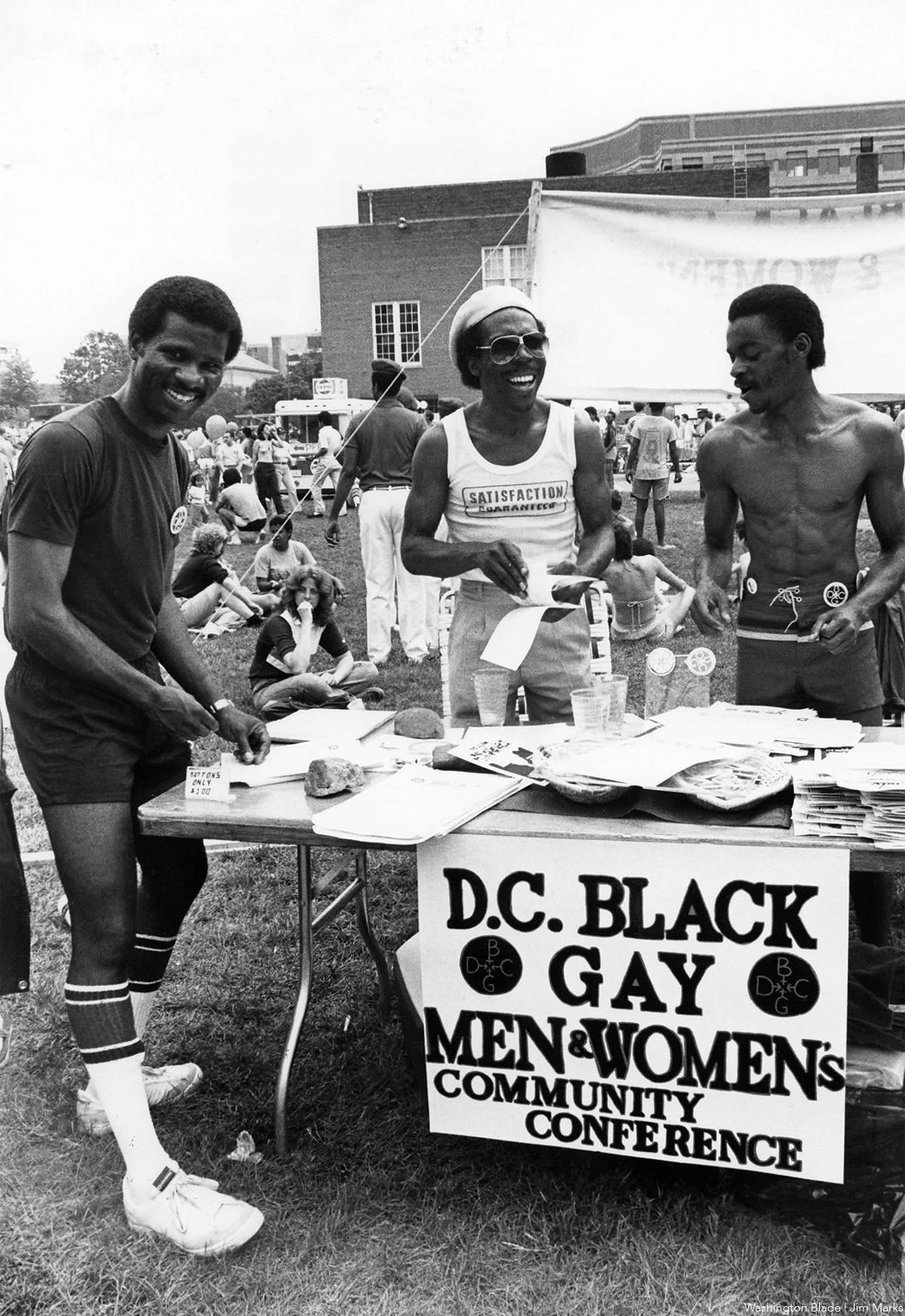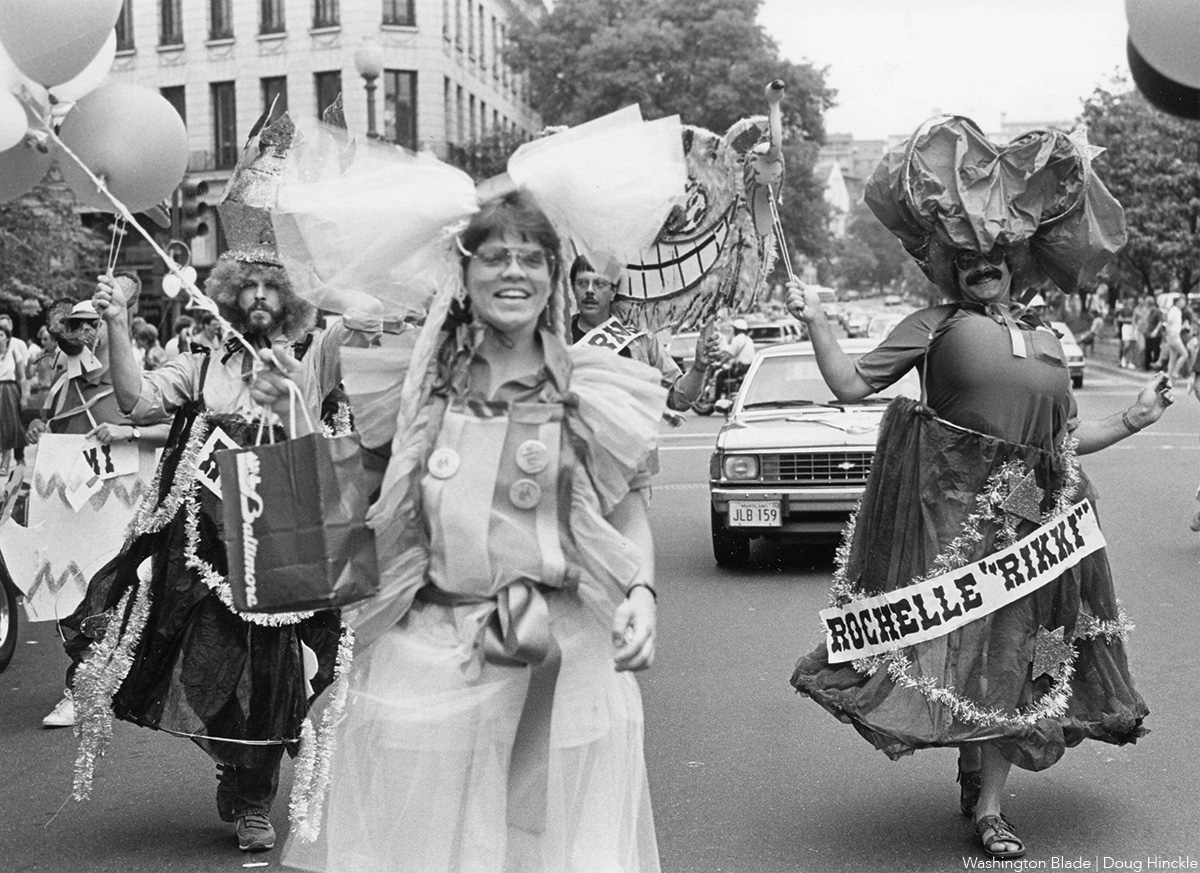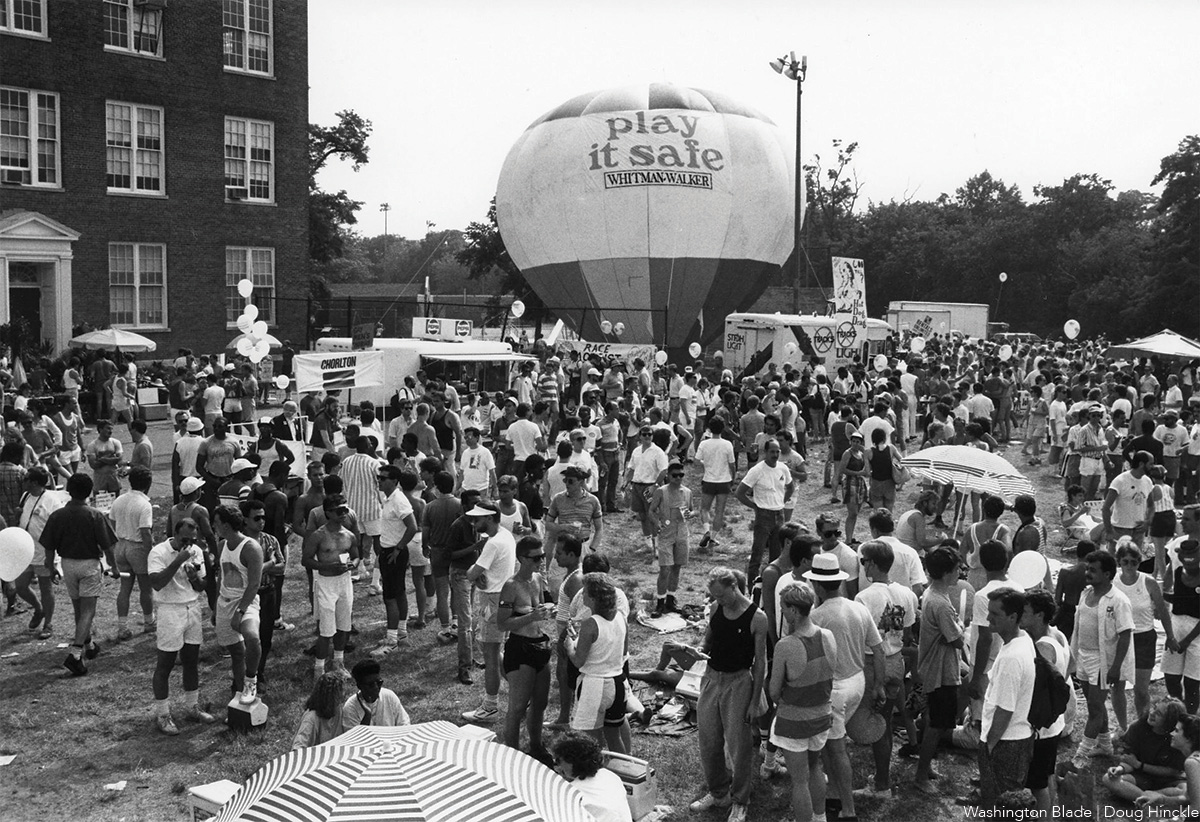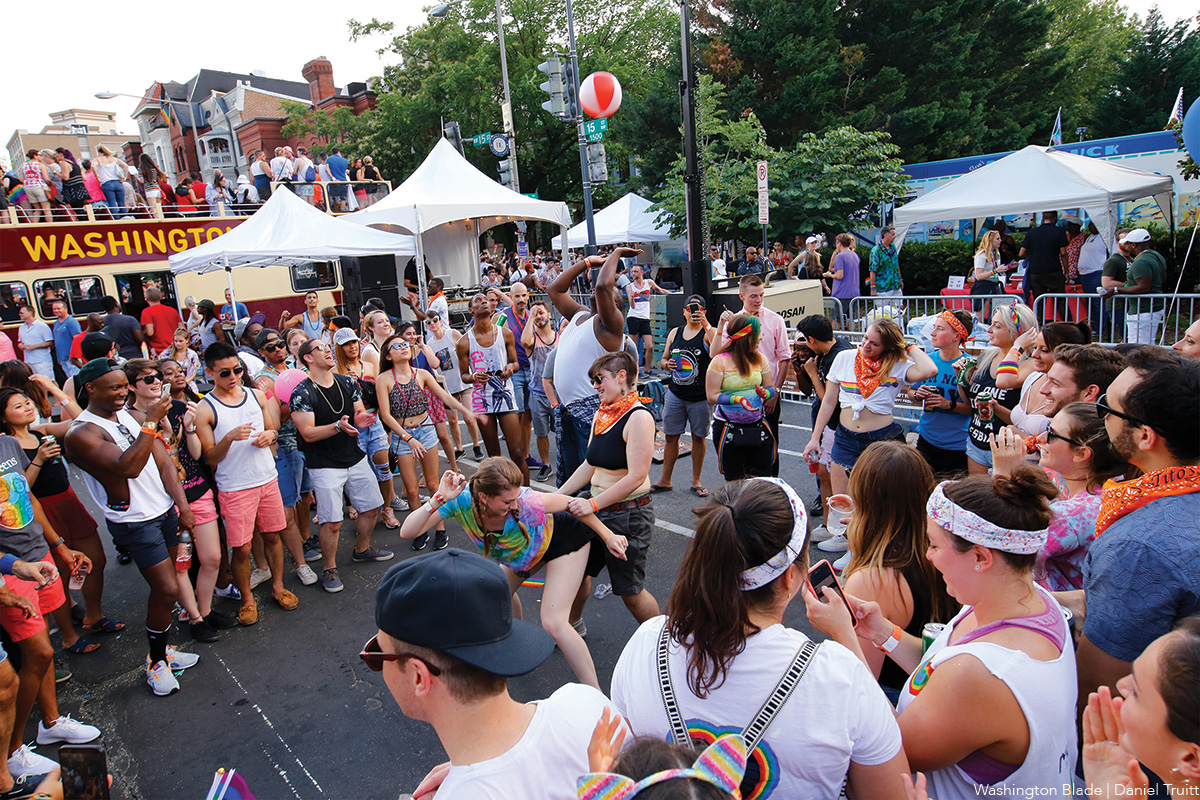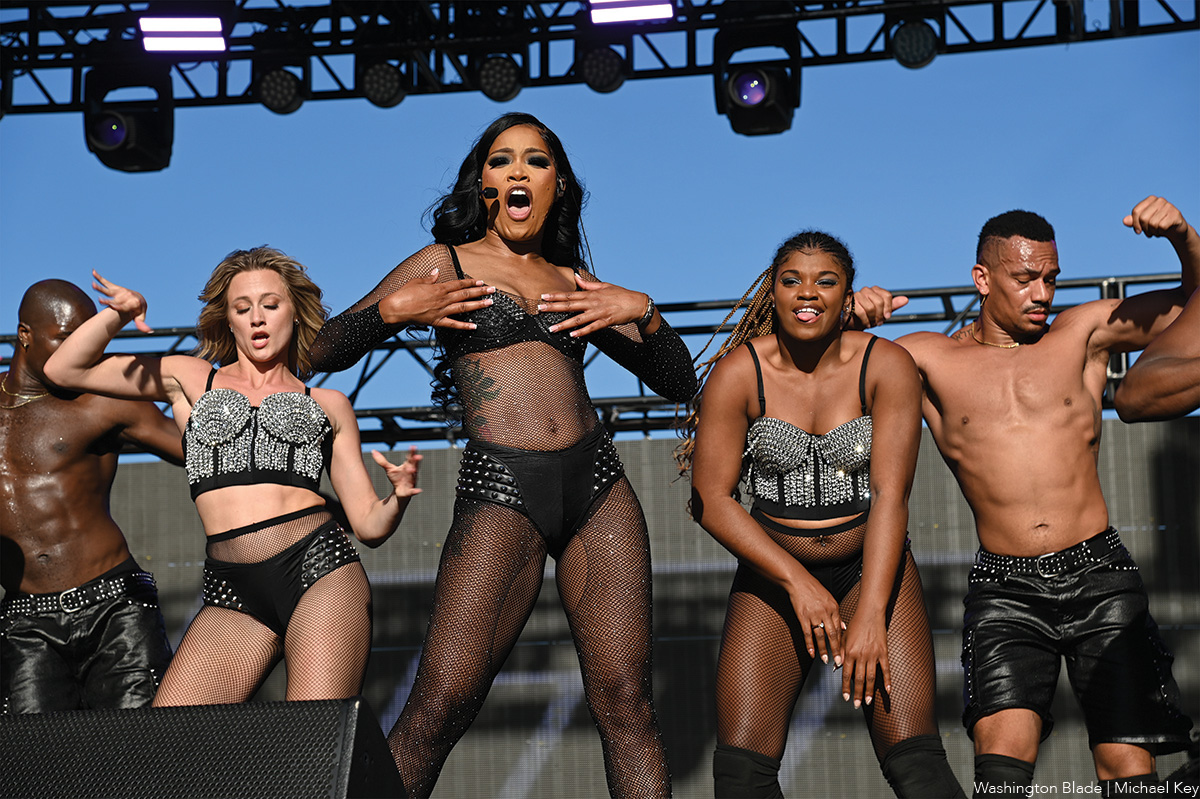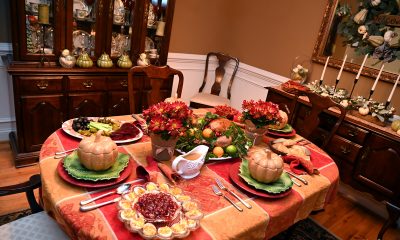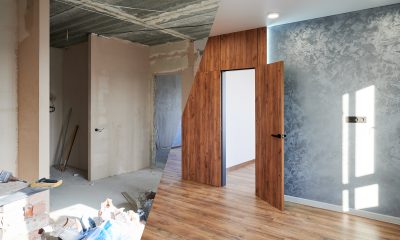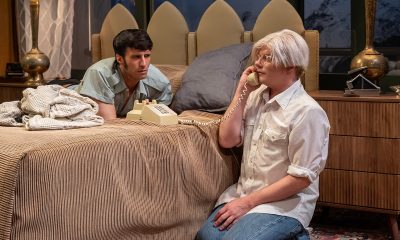a&e features
HGTV employs all six Brady ‘kids’ to help recreate their ’70s-tastic home
Adventures captured on new show ‘A Very Brady Renovation’
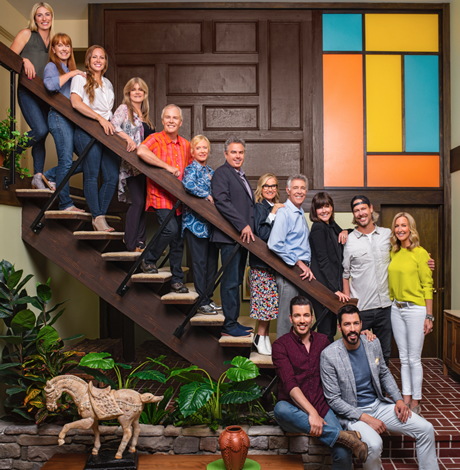
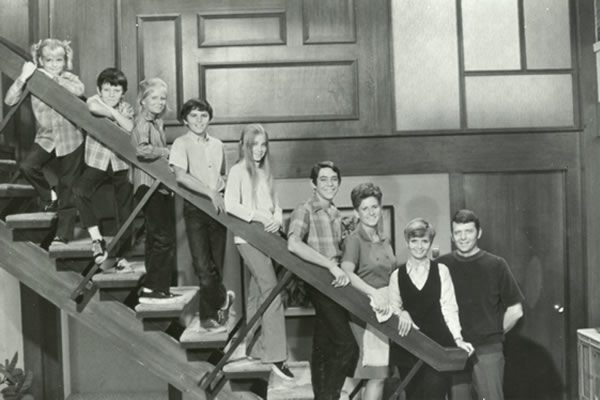
“Brady Bunch” fans were abuzz this week as HGTV unveiled its new show “A Very Brady Renovation” Monday night, which follows all surviving cast members of the original 1969-1974 series as they work with professional renovation experts to recreate their iconic home. The original series debuted 50 years ago this month.
Like most shows of the era, the exteriors seen on the series were a real house. Its interiors were never seen on the hit ABC series — all interiors were filmed on Stage 5 at Paramount Studios. When the house used for the exteriors — located at 11222 Dilling St., in Studio City, Calif., — went on the market last year, a bidding war erupted but HGTV won, purchasing the house for $3.5 million.
Almost immediately, the network planned a massive renovation to make the house look as much inside like the “house” was seen on TV. That involved adding 2,000 square feet to the original floor plan, a task that likely would have given even Mike Brady (an architect) a massive headache!
All six of the Brady “kids” — Barry Williams (Greg), Maureen McCormick (Marcia), Christopher Knight (Peter), Eve Plumb (Jan) and Mike Lookinland (Bobby) joined Jonathan and Drew Scott (“Property Brothers: Forever Home”) Mina Starsiak Hawk and Karen E. Laine (“Good Bones”), Leanne and Steve Ford (“Restored by the Fords”), Jasmine Roth (“Hidden Potential”) and Lara Spencer (“Flea Market Flip”) to execute was the network is calling “the boldest home renovation the world has ever seen.” (Sadly, Alice, Carol and Mike are no longer with us — Ann B. Davis died at age 88 in 2014, Florence Henderson died in 2016 at age 82 and Robert Reed, who was gay, died of AIDS in 1992 at 59.)
Roth, fresh off a red shag carpet event last week, spoke to the Blade by phone Sept. 6 about her work on the show.
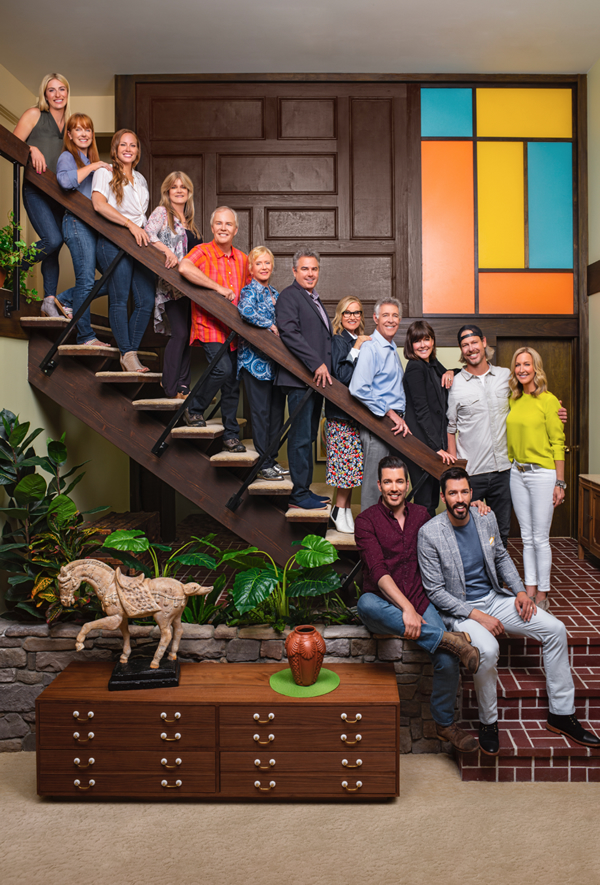
WASHINGTON BLADE: How did you come to be involved in the show/project?
JASMINE ROTH: I got a call and it was like, “Hey, we’re thinking about the Brady Bunch house …” and I was like, “Yeah, absolutely,” they didn’t even have to ask me. It was pretty early on, I don’t think they knew exactly what they were planning to do with the house at that point.
BLADE: Had you been a “Brady Bunch” fan as a kid?
ROTH: Yeah. My mom was a huge fan and watched it with her brother and sister the first time through and so when I was a kid, whenever it was on, she was like, “Oh my goodness, come watch this show, the ‘Brady Bunch’ is on.” I definitely grew up watching it, I knew all the characters, I knew the song, so when I got the call it was a no brainer. To say I’m a fan is an understatement.
BLADE: What did you actually do on the project?
ROTH: Each of us hosts were given different areas of the house. I was in charge of Mike’s den, which was a challenge because it was one of those rooms where a lot of scenes were shot, a lot of important scenes. It was a room people spent a lot of time looking at, so I knew I had to get it right with the drafting table and the green shutters and the little sofa. I was also in charge of the master bedroom … which, at the time, was the first time where a couple was shown sleeping together in the same bed, so for the TV world, that was a big deal.
BLADE: I could never figure out what that was supposed to be behind their bed — some kind of a screen or scrim or something? It wasn’t a wall.
ROTH: I think the idea of it was that it was a paper screen and a window behind it so the light would filter through, but of course, this was just on a set so there wasn’t any real light. But that kind of thing came up again and again because it wasn’t technically a real house on the show. One thing that was interesting, when the Brady kids came in, they went, “Oh my gosh, it has ceilings,” because of course on the set, it was just lights and microphones up there. But I think the headboard area was mean to be this kind of Asian-inspired paper shade. In our design, we made it out of bumpy glass and then we had the exact pattern from the set printed onto a kind of contact paper that adhered to the glass to give it that paper look, but more durable.
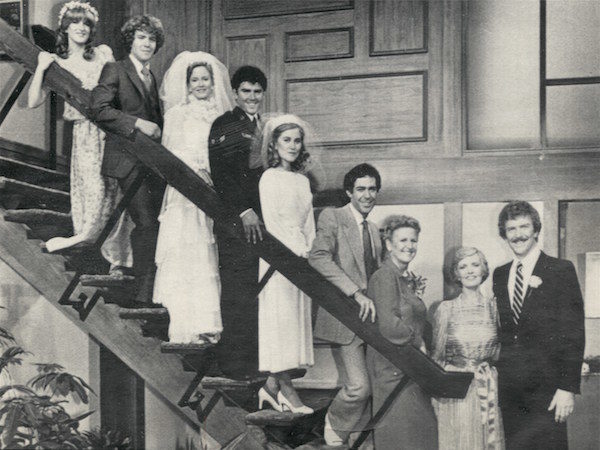
(file photo courtesy Paramount/ABC)
BLADE: The Bradys had so many interesting paintings (or reproductions) in their house. Did Paramount have those in its prop house or did you have to recreate them?
ROTH: Paramount did have a fair amount of items but we weren’t sure if they were from the original set, you know, they did a lot of reboots and specials and things over the years. But we were able to get as much as we possibly could. A lot of it was in pretty rough shape. … As for the paintings, we recreated most of them.
BLADE: Did the nationwide scavenger hunt for furniture and replicas turn up much you were able to use on the show?
ROTH: Oh my goodness, yes. There was a bust of a woman on the headboard of the bed a fan had bought at a thrift shop years before and donated. He didn’t even know at first it was the same on one the show but recognized it later. It’s the kind of thing you’d never consciously notice watching the show, yet the bedroom wouldn’t really be complete without it.
BLADE: Some of those little tchotchkes changed over the run of the show. Did you just pick the ones that were the most recognizable?
ROTH: Yeah, some changed, some didn’t. There were times we had to make decisions but if it was something that was there for multiple seasons, like the horse at the base of the stairs, obviously those had to be there.
BLADE: Did you find the original horse or is it a replica?
ROTH: Well, we found a horse at Paramount. We’re not sure if it was THE horse, but it looked a lot like it. But unfortunately a bunch of the legs had broken off. So we found a similar one at an online auction and we found a way to kind of meld together the pieces with a 3D printer to fix the parts that were broken on the original.
BLADE: There’s also a smaller horse in the den on the endtable beneath the lamp. For those less noticeable props, did you feel you had to find exact replicas or did close enough work?
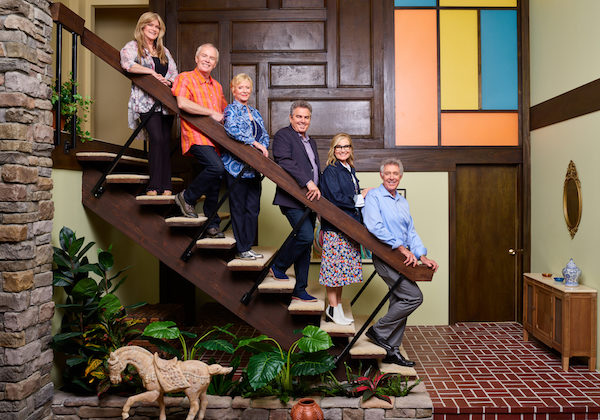
ROTH: We just did the best we could with the amount of time we had. We tried to get it as exact as possible down to the objects on the vanity table in the master bedroom and the setup of the books on the shelf in Mike’s den.
BLADE: How long did all this take?
ROTH: It was a six-month project; nine months total with the planning and everything.
BLADE: How were the Brady kids to work with?
ROTH: Oh my gosh, I didn’t know what to expect. I didn’t know if they were gonna want to show up and just kidna watch mostly or what. But they were all really ready to get their hands dirty and they were all super excited about it. They were fun and brought a lot of insight. I don’t think we could have done this project without them. Their memories of these spaces at the end of the day are what really brought it all together.
BLADE: Who was the hardest worker?
ROTH: I’d say it varied. Chris Knight was the biggest skeptic at the beginning. He just thought it was too big of a project, but then he ended up working harder than anyone else because he really wanted it to happen.
BLADE: Any of them you particularly clicked with?
ROTH: I worked with everybody. We were paired up with certain people on each room but I live in Orange County, so it’s close and I was able to be there a lot if I had a day off on my own show or I was literally waiting for paint to dry. So I got to work with every single Brady. Every one of them surprised me, that’s what I’ll say.
BLADE: Susan said once — it seemed kinda half-joking, half not — that when they get together they take care not to put Eve and Maureen next to each other. Did you sense any tension between those two?
ROTH: No, that’s so funny. No, I didn’t pick up on any tension at all honestly. We were so focused on the project, I don’t think there would have been time for anything like that or if there was, it would have just immediately dissipated.
BLADE: How did you even begin to add a second floor to the house without disturbing the facade? That seems crazy impossible.
ROTH: That was one of our biggest challenges. We knew we couldn’t mess with the front because that’s what everybody’s used to seeing. … We actually dug down and recessed the family room about a foot lower than it would have been on the set and that’s how we were able to accomplish the angle of the staircase, which was the most important. You know we had to get the staircase right.
BLADE: What will they do with this house now?
ROTH: That’s the million dollar question, I don’t know. It’s tough because there are a lot of restrictions. It’s in a residential neighborhood but it’s also Hollywood, so there’s that. I think it’s a matter of figuring out something that works for everybody but I honestly don’t know.
BLADE: How many episodes are there?
ROTH: I think four plus a bunch of online-only content.
BLADE: Which Brady kid did you most identify with as a kid?
ROTH: Marcia, although she was way cooler and way prettier. So kinda Marcia but in my dreams.
BLADE: Did it seem like there was genuine camaraderie between the Brady kids or no more than it might be for any of us catching up with coworkers from long ago. Don’t you think the public kind of projects onto them and imagines they’re BFFs and hanging out all the time and so on when probably really that’s not the case?
ROTH: Well they all grew up together and you can’t discount that. When you have that kind of shared experience at such a young age, it’s almost like a real brother or sister. They may not be getting together for dinner every week at this point in their lives, but they picked up right where they left off and we really had fun doing this project together. I think it’s a hundred percent genuine and they are truly brothers and sisters, even if it is just on TV.
Remembering Robert Reed
Despite having a combative relationship with “Brady Bunch” executive producer Sherwood Schwartz, gay actor Robert Reed, who was closeted most of his life, never missed a Brady reunion, having shown up for “The Brady Bunch Hour” (1976-1977), “The Brady Girls Get Married” (1981), “A Very Brady Christmas” (1988) and “The Bradys” (1990).
A lot of the tension centered around Reed, a classically trained actor, thinking the Brady scripts were too silly and implausible. Florence Henderson (Carol) and Barry Williams (Greg) in their respective memoirs (“Life is Not a Stage” and “Growing Up Brady”) have said Reed could be a pain to work with.
“If there was a source of recurring tension on the set, it usually concerned Bob,” Henderson writes. “He wanted ‘The Brady Bunch’ to be Shakespeare. It was the catalyst for terrible fights with Sherwood.”
Williams writes that although the tension continued through the life of the show and through its reunions, Reed was good to the young cast and they didn’t see a lot of the more terse exchanges. “He treated the kids as though they were his real family,” Henderson writes.
“I want to make it crystal clear that this sort of tension was not commonplace on the set … and was not exhibited in front of the kids,” Schwartz is quoted as having said in Williams’ book. “It almost always took place late in the shooting day, long after the Brady kids had gone home. Under normal everyday circumstances, our (set) was friendly, comfortable, relaxed and enjoyable. … Friction was an exception not the rule.”
Was Reed combative by nature or could some of his grumpiness come from being forced to stay in the closet pretty much his whole life? Henderson thinks that compounded his irritability.
“It’s hard to imagine what it must have been like in that era to be an actor in fear of losing his career if his sexual orientation were to become public,” she writes. “Being in that closet had to be a very stressful place.”
— JOEY DiGUGLIELMO
a&e features
Visit Cambridge, a ‘beautiful secret’ on Maryland’s Eastern Shore
New organization promotes town’s welcoming vibe, LGBTQ inclusion
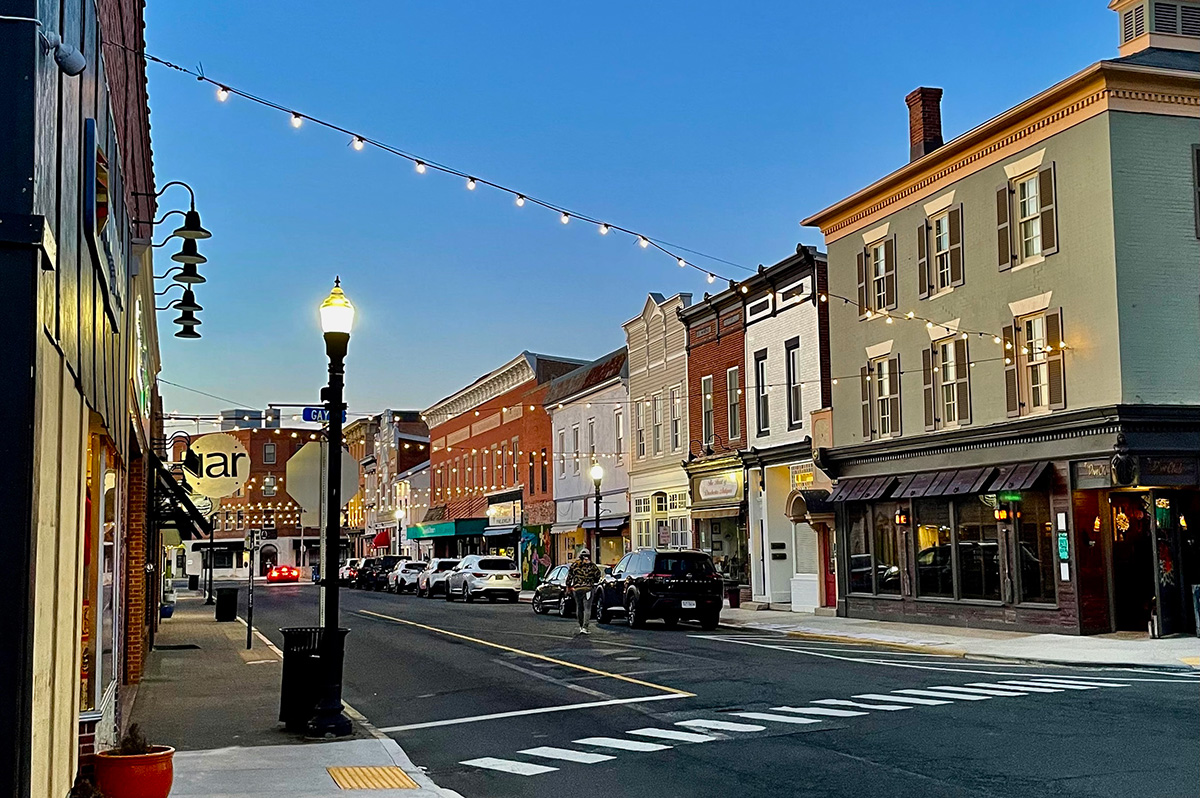
CAMBRIDGE, Md. — Driving through this scenic, historic town on Maryland’s Eastern Shore, you’ll be charmed by streets lined with unique shops, restaurants, and beautifully restored Victorian homes. You’ll also be struck by the number of LGBTQ Pride flags flying throughout the town.
The flags are a reassuring signal that everyone is welcome here, despite the town’s location in ruby red Dorchester County, which voted for Donald Trump over Kamala Harris by a lopsided margin. But don’t let that deter you from visiting. A new organization, Proudly Cambridge, is holding its debut Pride event this weekend, touting the town’s welcoming, inclusive culture.
“We stumbled on a beautiful secret and we wanted to help get the word out,” said James Lumalcuri of the effort to create Proudly Cambridge.
The organization celebrates diversity, enhances public spaces, and seeks to uplift all that Cambridge has to share, according to its mission statement, under the tagline “You Belong Here.”
The group has so far held informal movie nights and a picnic and garden party; the launch party is June 28 at the Cambridge Yacht Club, which will feature a Pride celebration and tea dance. The event’s 75 tickets sold out quickly and proceeds benefit DoCo Pride.
“Tickets went faster than we imagined and we’re bummed we can’t welcome everyone who wanted to come,” Lumalcuri said, adding that organizers plan to make “Cheers on the Choptank” an annual event with added capacity next year.
One of the group’s first projects was to distribute free Pride flags to anyone who requested one and the result is a visually striking display of a large number of flags flying all over town. Up next: Proudly Cambridge plans to roll out a program offering affirming businesses rainbow crab stickers to show their inclusiveness and LGBTQ support. The group also wants to engage with potential visitors and homebuyers.
“We want to spread the word outside of Cambridge — in D.C. and Baltimore — who don’t know about Cambridge,” Lumalcuri said. “We want them to come and know we are a safe haven. You can exist here and feel comfortable and supported by neighbors in a way that we didn’t anticipate when we moved here.”
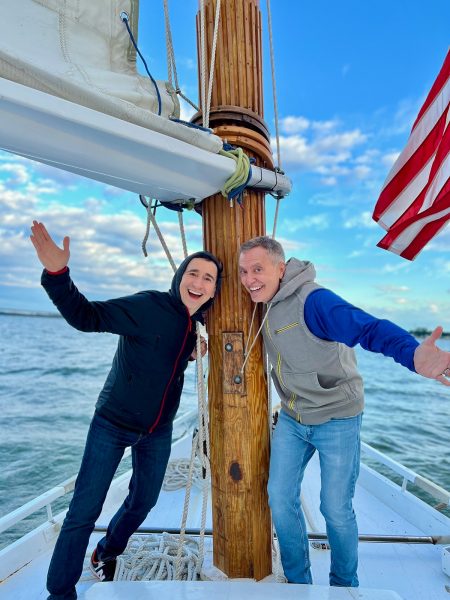
Lumalcuri, 53, a federal government employee, and his husband, Lou Cardenas, 62, a Realtor, purchased a Victorian house in Cambridge in 2021 and embarked on an extensive renovation. The couple also owns a home in Adams Morgan in D.C.
“We saw the opportunity here and wanted to share it with others,” Cardenas said. “There’s lots of housing inventory in the $300-400,000 range … we’re not here to gentrify people out of town because a lot of these homes are just empty and need to be fixed up and we’re happy to be a part of that.”
Lumalcuri was talking with friends one Sunday last year at the gazebo (affectionately known as the “gayzebo” by locals) at the Yacht Club and the idea for Proudly Cambridge was born. The founding board members are Lumalcuri, Corey van Vlymen, Brian Orjuela, Lauren Mross, and Caleb Holland. The group is currently working toward forming a 501(c)3.
“We need visibility and support for those who need it,” Mross said. “We started making lists of what we wanted to do and the five of us ran with it. We started meeting weekly and solidified what we wanted to do.”
Mross, 50, a brand strategist and web designer, moved to Cambridge from Atlanta with her wife three years ago. They knew they wanted to be near the water and farther north and began researching their options when they discovered Cambridge.
“I had not heard of Cambridge but the location seemed perfect,” she said. “I pointed on a map and said this is where we’re going to move.”
The couple packed up, bought a camper trailer and parked it in different campsites but kept coming back to Cambridge.
“I didn’t know how right it was until we moved here,” she said. “It’s the most welcoming place … there’s an energy vortex here – how did so many cool, progressive people end up in one place?”
Corey van Vlymen and his husband live in D.C. and were looking for a second home. They considered Lost River, W.Va., but decided they preferred to be on the water.
“We looked at a map on both sides of the bay and came to Cambridge on a Saturday and bought a house that day,” said van Vlymen, 39, a senior scientist at Booz Allen Hamilton. They’ve owned in Cambridge for two years.
They were drawn to Cambridge due to its location on the water, the affordable housing inventory, and its proximity to D.C.; it’s about an hour and 20 minutes away.
Now, through the work of Proudly Cambridge, they hope to highlight the town’s many attributes to residents and visitors alike.
“Something we all agree on is there’s a perception problem for Cambridge and a lack of awareness,” van Vlymen said. “If you tell someone you’re going to Cambridge, chances are they think, ‘England or Massachusetts?’”
He cited the affordability and the opportunity to save older, historic homes as a big draw for buyers.
“It’s all about celebrating all the things that make Cambridge great,” Mross added. “Our monthly social events are joyful and celebratory.” A recent game night drew about 70 people.
She noted that the goal is not to gentrify the town and push longtime residents out, but to uplift all the people who are already there while welcoming new visitors and future residents.
They also noted that Proudly Cambridge does not seek to supplant existing Pride-focused organizations. Dorchester County Pride organizes countywide Pride events and Delmarva Pride was held in nearby Easton two weeks ago.
“We celebrate all diversity but are gay powered and gay led,” Mross noted.
To learn more about Proudly Cambridge, visit the group on Facebook and Instagram.
What to see and do
Cambridge, located 13 miles up the Choptank River from the Chesapeake Bay, has a population of roughly 15,000. It was settled in 1684 and named for the English university town in 1686. It is home to the Harriet Tubman Museum, mural, and monument. Its proximity to the Blackwater National Wildlife Refuge makes it a popular stop for birders, drawn to more than 27,000 acres of marshland dubbed “the Everglades of the north.”
The refuge is walkable, bikeable, and driveable, making it an accessible attraction for all. There are kayaking and biking tours through Blackwater Adventures (blackwateradventuresmd.com).
Back in town, take a stroll along the water and through historic downtown and admire the architecture. Take in the striking Harriet Tubman mural (424 Race St.). Shop in the many local boutiques, and don’t miss the gay-owned Shorelife Home and Gifts (421 Race St.), filled with stylish coastal décor items.
Stop for breakfast or lunch at Black Water Bakery (429 Race St.), which offers a full compliment of coffee drinks along with a build-your-own mimosa bar and a full menu of creative cocktails.
The Cambridge Yacht Club (1 Mill St.) is always bustling but you need to be a member to get in. Snapper’s on the water is temporarily closed for renovations. RaR Brewing (rarbrewing.com) is popular for craft beers served in an 80-year-old former pool hall and bowling alley. The menu offers burgers, wings, and other bar fare.
For dinner or wine, don’t miss the fantastic Vintage 414 (414 Race St.), which offers lunch, dinner, wine tasting events, specialty foods, and a large selection of wines. The homemade cheddar crackers, inventive flatbreads, and creative desserts (citrus olive oil cake, carrot cake trifle) were a hit on a recent visit.
Also nearby is Ava’s (305 High St.), a regional chain offering outstanding Italian dishes, pizzas, and more.
For something off the beaten path, visit Emily’s Produce (22143 Church Creek Rd.) for its nursery, produce, and prepared meals.
“Ten minutes into the sticks there’s a place called Emily’s Produce, where you can pay $5 and walk through a field and pick sunflowers, blueberries, you can feed the goats … and they have great food,” van Vlymen said.
As for accommodations, there’s the Hyatt Regency Chesapeake Bay (100 Heron Blvd. at Route 50), a resort complex with golf course, spa, and marina. Otherwise, check out Airbnb and VRBO for short-term rentals closer to downtown.
Its proximity to D.C. and Baltimore makes Cambridge an ideal weekend getaway. The large LGBTQ population is welcoming and they are happy to talk up their town and show you around.
“There’s a closeness among the neighbors that I wasn’t feeling in D.C.,” Lumalcuri said. “We look after each other.”
a&e features
James Baldwin bio shows how much of his life is revealed in his work
‘A Love Story’ is first major book on acclaimed author’s life in 30 years

‘Baldwin: A Love Story’
By Nicholas Boggs
c.2025, FSG
$35/704 pages
“Baldwin: A Love Story” is a sympathetic biography, the first major one in 30 years, of acclaimed Black gay writer James Baldwin. Drawing on Baldwin’s fiction, essays, and letters, Nicolas Boggs, a white writer who rediscovered and co-edited a new edition of a long-lost Baldwin book, explores Baldwin’s life and work through focusing on his lovers, mentors, and inspirations.
The book begins with a quick look at Baldwin’s childhood in Harlem, and his difficult relationship with his religious, angry stepfather. Baldwin’s experience with Orilla Miller, a white teacher who encouraged the boy’s writing and took him to plays and movies, even against his father’s wishes, helped shape his life and tempered his feelings toward white people. When Baldwin later joined a church and became a child preacher, though, he felt conflicted between academic success and religious demands, even denouncing Miller at one point. In a fascinating late essay, Baldwin also described his teenage sexual relationship with a mobster, who showed him off in public.
Baldwin’s romantic life was complicated, as he preferred men who were not outwardly gay. Indeed, many would marry women and have children while also involved with Baldwin. Still, they would often remain friends and enabled Baldwin’s work. Lucien Happersberger, who met Baldwin while both were living in Paris, sent him to a Swiss village, where he wrote his first novel, “Go Tell It on the Mountain,” as well as an essay, “Stranger in the Village,” about the oddness of being the first Black person many villagers had ever seen. Baldwin met Turkish actor Engin Cezzar in New York at the Actors’ Studio; Baldwin later spent time in Istanbul with Cezzar and his wife, finishing “Another Country” and directing a controversial play about Turkish prisoners that depicted sexuality and gender.
Baldwin collaborated with French artist Yoran Cazac on a children’s book, which later vanished. Boggs writes of his excitement about coming across this book while a student at Yale and how he later interviewed Cazac and his wife while also republishing the book. Baldwin also had many tumultuous sexual relationships with young men whom he tried to mentor and shape, most of which led to drama and despair.
The book carefully examines Baldwin’s development as a writer. “Go Tell It on the Mountain” draws heavily on his early life, giving subtle signs of the main character John’s sexuality, while “Giovanni’s Room” bravely and openly shows a homosexual relationship, highly controversial at the time. “If Beale Street Could Talk” features a woman as its main character and narrator, the first time Baldwin wrote fully through a woman’s perspective. His essays feel deeply personal, even if they do not reveal everything; Lucian is the unnamed visiting friend in one who the police briefly detained along with Baldwin. He found New York too distracting to write, spending his time there with friends and family or on business. He was close friends with modernist painter Beauford Delaney, also gay, who helped Baldwin see that a Black man could thrive as an artist. Delaney would later move to France, staying near Baldwin’s home.
An epilogue has Boggs writing about encountering Baldwin’s work as one of the few white students in a majority-Black school. It helpfully reminds us that Baldwin connects to all who feel different, no matter their race, sexuality, gender, or class. A well-written, easy-flowing biography, with many excerpts from Baldwin’s writing, it shows how much of his life is revealed in his work. Let’s hope it encourages reading the work, either again or for the first time.
a&e features
Looking back at 50 years of Pride in D.C
Washington Blade’s unique archives chronicle highs, lows of our movement
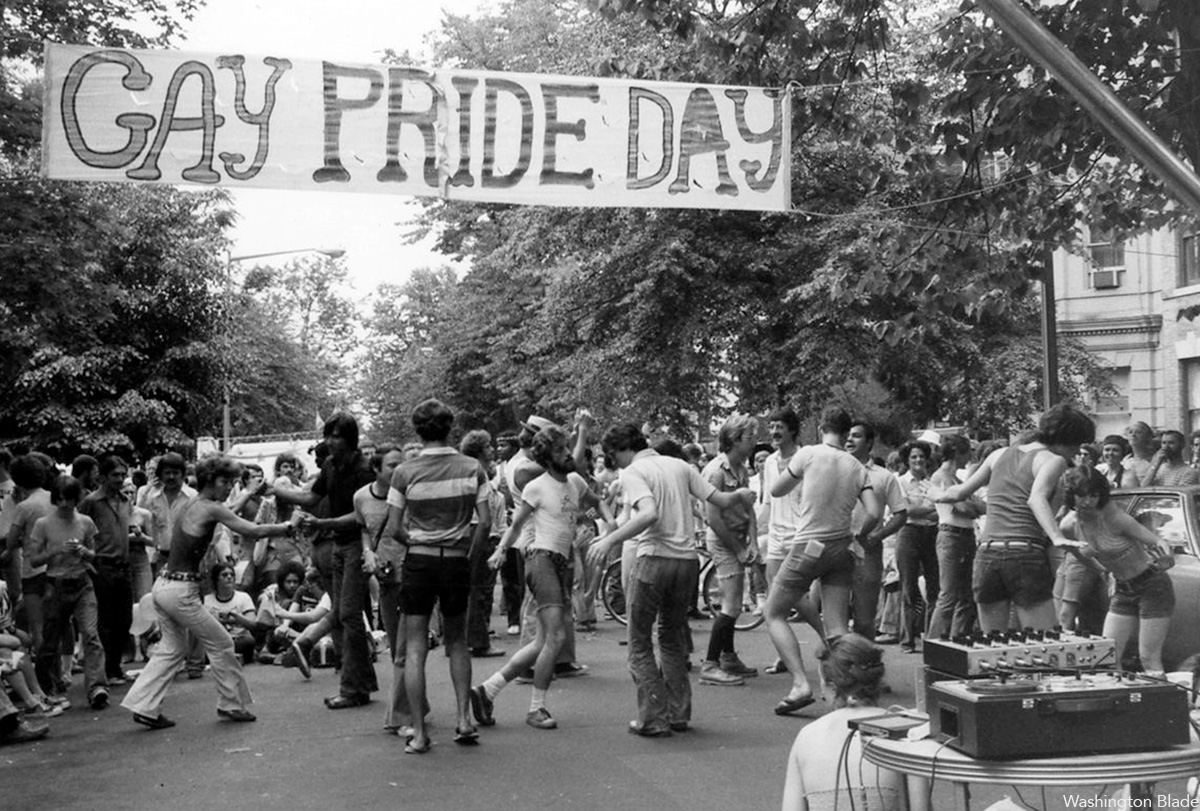
To celebrate the 50th anniversary of LGBTQ Pride in Washington, D.C., the Washington Blade team combed our archives and put together a glossy magazine showcasing five decades of celebrations in the city. Below is a sampling of images from the magazine but be sure to find a print copy starting this week.
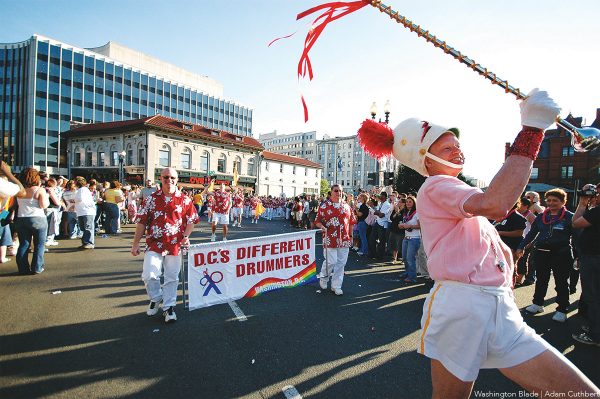
The magazine is being distributed now and is complimentary. You can find copies at LGBTQ bars and restaurants across the city. Or visit the Blade booth at the Pride festival on June 7 and 8 where we will distribute copies.
Thank you to our advertisers and sponsors, whose support has enabled us to distribute the magazine free of charge. And thanks to our dedicated team at the Blade, especially Photo Editor Michael Key, who spent many hours searching the archives for the best images, many of which are unique to the Blade and cannot be found elsewhere. And thanks to our dynamic production team of Meaghan Juba, who designed the magazine, and Phil Rockstroh who managed the process. Stephen Rutgers and Brian Pitts handled sales and marketing and staff writers Lou Chibbaro Jr., Christopher Kane, Michael K. Lavers, Joe Reberkenny along with freelancer and former Blade staffer Joey DiGuglielmo wrote the essays.

The magazine represents more than 50 years of hard work by countless reporters, editors, advertising sales reps, photographers, and other media professionals who have brought you the Washington Blade since 1969.
We hope you enjoy the magazine and keep it as a reminder of all the many ups and downs our local LGBTQ community has experienced over the past 50 years.
I hope you will consider supporting our vital mission by becoming a Blade member today. At a time when reliable, accurate LGBTQ news is more essential than ever, your contribution helps make it possible. With a monthly gift starting at just $7, you’ll ensure that the Blade remains a trusted, free resource for the community — now and for years to come. Click here to help fund LGBTQ journalism.
